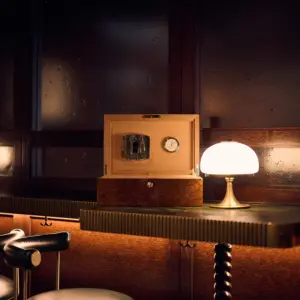Watch Winder vs. Watch Box: The Ultimate Guide
As your watch collection grows, so does the need to care for it properly. You’ve invested in magnificent timepieces, and now you face a crucial decision: how do you store them? The debate between a watch winder and a watch box is a common one among enthusiasts. While both protect your watches, they serve fundamentally different purposes that impact the health and longevity of your collection. This guide will explore the functions of each, helping you decide which is the right choice for your cherished watches.
The Purpose of a Watch Winder
A watch winder is more than just a storage case; it’s an active maintenance tool designed specifically for automatic watches. An automatic, or self-winding, watch is powered by the natural motion of your wrist. A rotor inside the movement spins with your movements, winding the mainspring and keeping the watch running. When you take the watch off, its power reserve begins to deplete.
This is where a watch winder comes in. It’s a device that holds your watch and gently rotates it to simulate the motion of your wrist, keeping the mainspring wound and the movement running continuously. For collectors who rotate through several automatic watches, a winder is invaluable. It ensures that when you pick up a watch after a few days, it’s ready to wear—no need to reset the time, date, or any complex functions.
When is a Watch Winder the Right Choice?
A high-quality winder is particularly advantageous for certain types of watches and lifestyles.
Complex Complications
If you own a watch with a perpetual calendar, annual calendar, or moonphase, you know that resetting it can be a complicated task. A watch winder keeps these intricate mechanisms running, saving you the hassle and potential risk of damaging the movement during a manual reset. Imagine a Patek Philippe Annual Calendar or an IWC Portugieser automatic; keeping them on a winder means their sophisticated functions remain perfectly synchronized.
Maintaining Accuracy
Modern automatic movements, like the Rolex calibre 3235 found in the Submariner and Datejust or the Omega Co-Axial Master Chronometer in a Seamaster, are engineered for exceptional accuracy when running continuously. A winder keeps the internal lubricants evenly distributed, preventing them from coagulating and ensuring the movement operates within its optimal chronometric specifications.
Convenience for a Collection
For enthusiasts who own multiple automatic watches and enjoy wearing a different one each day, a multi-watch winder is a game-changer. It keeps your entire rotation ready to go at a moment’s notice. You can simply choose your watch for the day and go, knowing it’s accurate and fully powered.
What Makes a Quality Watch Winder?
Not all winders are created equal. A poor-quality winder can actually harm your watch by overwinding it or magnetizing the movement. Look for winders from reputable brands like WOLF, which is known for its patented technology that counts the precise number of rotations, or Rapport London and Volta, which offer sophisticated engineering and elegant designs. Key features to consider include:
- Turns Per Day (TPD) Settings: Different watch movements require different TPD counts. A premium winder allows you to customize this setting for each watch.
- Directional Control: Some watches wind clockwise, others counter-clockwise, and some are bidirectional. A good winder offers all three options.
- Silent Motor: A quality motor from brands like Billstone will be virtually silent, making it suitable for a bedroom or office.
- Secure Cushioning and Shielding: The cuff that holds your watch should be secure yet soft to prevent scratches, and the device should have magnetic shielding to protect the movement.
The Role of a Traditional Watch Box
A watch box is the classic solution for storing, organizing, and protecting your timepieces. It is a static storage case, often beautifully crafted from wood, leather, or other fine materials, with a soft interior lining to prevent scratches. Its primary function is to keep your watches safe from dust, moisture, and impact when they are not being worn.
When is a Watch Box the Ideal Solution?
While a winder is essential for some, a watch box is often the more practical and sometimes safer choice for other types of watches.
Manual-Wind and Quartz Watches
A watch winder offers no benefit to manual-wind watches, which require you to turn the crown to power the movement, or quartz watches, which are battery-powered. For these timepieces, a simple, elegant watch box is the perfect storage solution.
Vintage Timepieces
Many older vintage watches were not designed for the continuous motion of a modern winder. Their movements can be more delicate, and constant winding may cause premature wear on components. For these historical pieces, resting them in a secure watch box is the safest approach.
Long-Term Storage
If you plan to store a watch for many months or even years without wearing it, a watch box is the best option. It is not advisable to leave an automatic watch on a winder indefinitely. Like any mechanical device, watch movements benefit from periodic rest. For long-term storage, it’s best to let the watch wind down and store it in a box, preferably in a place with stable humidity. When you decide to wear it again, you can simply give it a full manual wind and set the time.
Organization and Display
Watch boxes are perfect for organizing your collection and showcasing its beauty. Many feature glass tops that allow you to admire your timepieces while keeping them protected. They create a handsome presentation on a dresser or in a safe, turning your collection into a display of horological art.
The Verdict: Winder or Box?
The decision between a watch winder and a watch box depends entirely on your collection and your habits. You don’t have to choose one over the other; in fact, many serious collectors use both.
Choose a watch winder if:
- You primarily own automatic watches, especially those with complex complications.
- You rotate through several automatic watches regularly and value the convenience of having them always ready.
- You want to maintain the peak accuracy and health of modern movements like those from Rolex or Omega.
Choose a watch box if:
- Your collection includes manual-wind, quartz, or delicate vintage watches.
- You need a solution for long-term storage.
- Your main priorities are organization, protection from the elements, and displaying your collection.
Ultimately, both accessories are investments in the longevity and enjoyment of your watches. By understanding their distinct roles, you can make an informed choice. A high-quality winder from a brand like WOLF or Rapport London keeps your daily automatics running smoothly, while a beautiful watch box provides a safe and elegant home for the rest of your treasured collection.










